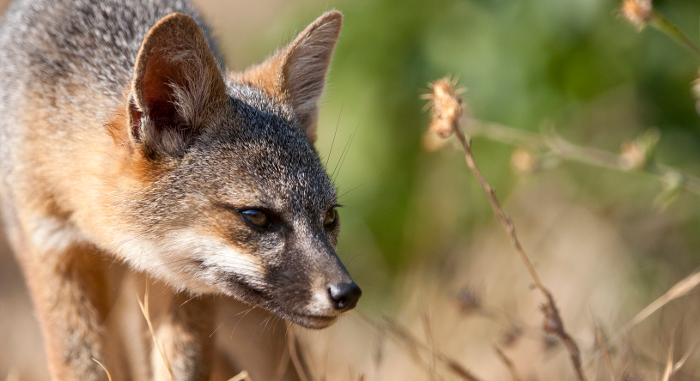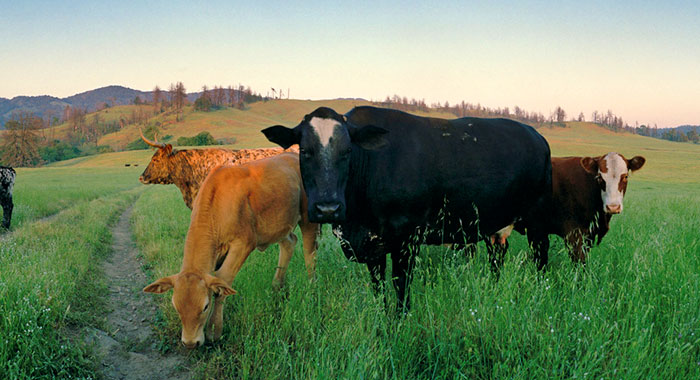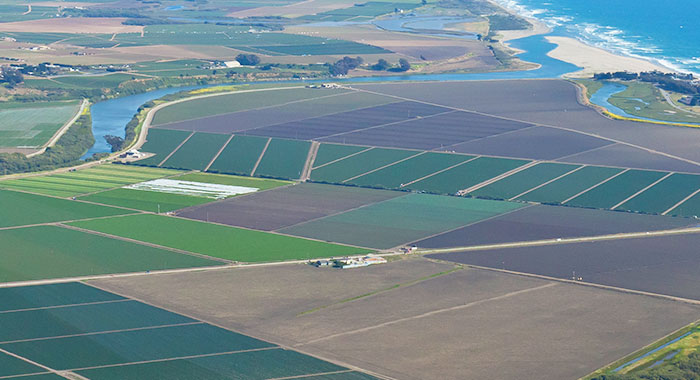In California, a day’s drive can take a visitor from record-setting desert heat to glaciated peaks to temperate rainforests with the world’s tallest trees. This astounding climatic and landscape diversity has helped create a biodiversity hotspot. California is also an economic hotspot – the 6th largest economy in the world – and is home to nearly 40 million people. The demand for land for new development and farms, along with accelerating climate change, puts tremendous stress on ecosystems, and the benefits they provide.
The state’s legacy of conservation has created a network of natural and working lands that benefit people by supplying clean water, capturing carbon, and directly contributing to the state’s economic and cultural vitality through recreation, tourism, and agricultural production. Conservancy scientists work across the spectrum of ecosystem types and human land uses, to advance conservation goals that also contribute to the well-being of people in those places.






Tim Bean, Bob Stafford, Scott Butterfield, Justin Brashares
This paper presents a multi-step approach to estimate the realized and potential distribution of the endangered giant kangaroo rat. The authors estimate the potential distribution by modeling…Beltran, R.S., N. Kreidler, D.H. Van Vuren, S.A. Morrison, E.S. Zavaleta, K. Newton, B.R. Tershy, D.A. Croll
Introduced predators and herbivores can have dramatic ecological effects on island ecosystems; their eradication can produce similarly profound ecological responses. This paper analyzes data from…Eric Hallstein, Matt Miller
Cameron DR, Marty J, Holland RF
This study assesses the amount of rangeland conversion between 1984 and 2008 in California. The researchers analyzed data from the California Farmland Mapping and Monitoring Program to see where…Rick, T.C, T.S. Sillett, C.K. Ghalambor, C.A. Hofman, K. Ralls, R.S. Anderson, C.L. Boser, T.J. Braje, D.R. Cayan, R.T. Chesser, P.W. Collins, J.M. Erlandson, K.R. Faulkner, R. Fleischer, W.C. Funk, R. Galipeau, A. Huston, J. King, L. Laughrin, J. Maldonado, K. McEachern, D.R. Muhs, S.D. Newsome, L. Reeder-Myers, C. Still, S.A. Morrison
Understanding the deep history of places and resources, and the interplay between natural and cultural histories, can be critical to science-based conservation management. This paper explores the case…B. C. Mclaughlin, C. N. Morozumi, J. MacKenzie, A. Cole, S. Gennet
Anticipating how species will move as the climate changes is a fundamental concern in 21st century conservation. This study modeled potential responses of blue oak (Quercus douglasii), an…H. Scott Butterfield, Miriam Tsalyuk, Carrie Schloss
The Nature Conservancy in California monitors residual dry matter (RDM) on approximately 300,000 acres of conservation lands. Researchers evaluated whether satellite remote sensing data could be used…Tim Bean, Laura Prugh, Bob Stafford, Scott Butterfield, Mike Westphal, Justin Brashares
In this study, the authors developed a suite of species distribution models (SDMs) for the endangered giant kangaroo rat using the machine-learning method Maxent. They compared these models with three…H.R. Sofaer, T.S. Sillett, K.M. Langin, S.A. Morrison, C.K. Ghalambor
The density of birds in their breeding areas can affect reproductive success in myriad ways – and it is often difficult to distinguish which factors are more influential. For example, areas that…S.A. Morrison, K.A. Parker, P.W. Collins, W.C. Funk, T.S. Sillett
Pest eradication as a means to restore island ecosystems may come too late for populations that have already been driven extinct. Over decades, the California islands have been the focus of numerous…CL Boser, C Hanna, KR Faulkner, C Cory, JM Randall, SA Morrison
Argentine ants are a highly aggressive and impactful non-native species introduced to California and around the world, impacting ecologically sensitive areas, commercial industries and residential…TJ Coonan, V Bakker, B Hudgens, CL Boser, DK Garcelon, SA Morrison
The island fox is a rare carnivore existing on only six California Channel Islands. In the late 1990’s, due to new and excessive golden eagle predation, it was threatened with extinction on the…Jeanne M. Robertson, Kathryn M. Langin, T. Scott Sillett, Scott A. Morrison, Cameron K. Ghalambor, W. Chris Funk
Conservation of biodiversity can be complicated when there are many priority taxa and tradeoffs in management need to be made. This can be especially challenging on islands, where populations with…Mario B. Pesendorfer, Kathryn M. Langin, Brian Cohen, Zachary Principe, Scott A. Morrison, T. Scott Sillett
Acorns are an important food resource for many species that occupy oak habitats. Patterns of acorn abundance across time and space, however, are often difficult to characterize. This paper describes…CL Boser, C Cory, KR Faulkner, JM Randall, JJ Knapp, SA Morrison
Biosecurity is the prevention of damaging non-native species’ arrival and establishment to new areas, for the protection of native plants and animals. This paper discusses the first iterations…Michelle D Staudinger, Shawn L Carter, Molly S Cross, Natalie S Dubois, J Emmett Duffy, Carolyn Enquist, Roger Griffis, Jessica J Hellmann, Joshua J Lawler, John O'Leary, Scott A Morrison, Lesley Sneddon, Bruce A Stein, Laura M Thompson, Woody Turner
This paper synthesizes research pertaining to climate change impacts on biodiversity, reviewed by the biodiversity technical working group of the 2014 National Climate Assessment. The paper focuses on…